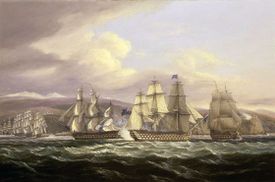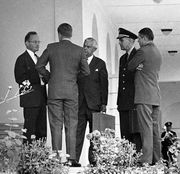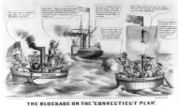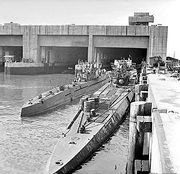Blockade


A blockade is an effort to cut off food, supplies, war material or communications from a particular area by force, either in part or totally. A blockade should not be confused with an embargo or sanctions, which are legal barriers to trade, and is distinct from a siege in that a blockade is usually directed at an entire country or region, rather than a fortress or city. Also, a blockade historically took place at sea, with the blockading power seeking to cut off all maritime transport from and to the blockaded country; although stopping all land transport to and from an area may also be considered a blockade.
Close patrol of a hostile port, in order to prevent naval forces from putting to sea, is also referred to as a blockade. When a coastal city or fortress was besieged from the landward side, the besiegers would often blockade the seaward side as well. In the twentieth century, blockades sometimes included stopping all air traffic within the blockaded area. Most recently, blockades have sometimes included cutting off electronic communications by jamming radio signals and severing undersea cables.
Contents |
Types of blockade
Close, distant and loose blockades
A close blockade entails placing warships within sight of the blockaded coast or port, to ensure the immediate interception of any ship entering or leaving. It is both the most effective and the most difficult form of blockade to implement. Difficulties arise because the blockading ships must remain continuously at sea, exposed to storms and hardship, vulnerable to sudden attack from the blockaded side, whose ships may stay safe in harbor till they choose to come out and usually far from any support.
In a distant blockade, the blockaders stay well away from the blockaded coast, and try to intercept any ships going in or out. This may require more ships on station, but they can usually operate closer to their bases, and are at much less risk from enemy raids.
A loose blockade is a close blockade where the blockading ships are withdrawn out of sight from the coast (behind the horizon), but no farther. The object of loose blockade is to lure the enemy into venturing out, while staying close enough to strike.
British admiral Horatio Nelson applied a loose blockade at Cádiz in 1805. The Franco-Spanish fleet under Villeneuve then came out, resulting in the battle of Trafalgar.[1]
Pacific blockade
Until 1827, blockades were always a part of a war. This changed when France, Russia and Britain came to the aid of the Greek rebels against Turkey. They blockaded the Turkish-occupied coast, which led to the battle of Navarino. War was never declared, however, so it is considered the first pacific — i.e. peaceful — blockade.[2] The first truly pacific blockade, involving no shooting at all, was the British blockade of the Republic of New Granada in 1837, established to compel New Granada to release an imprisoned British consul.[3]
Legal status

Act of war
A blockade is defined by the Encyclopedia Britannica as "an act of war by which a belligerent prevents access to or departure from a defined part of the enemy’s coasts."[4]
Governing laws
Whether or not a blockade was seen as lawful depended on the national laws of the nations whose trade was influenced by the blockade. The Brazilian blockade of Río de la Plata in 1826, for instance, was considered lawful according to British law, but unlawful according to French and American law. The latter two countries announced they would actively defend their ships against Brazilian blockaders, while Britain was forced to steer for a peaceful solution between Brazil and Argentina.[5]
Blockades were first defined in international law at the Congress of Paris in 1856. One of the agreed rules was that a blockade had to be effective in order to be lawful. This banned so-called "paper" blockades — blockades that were declared to the blockaded nation, but were not actively enforced, allowing the blockading party to seize the cargo of neutral states trading with blockaded harbors.[6] At the Declaration of London in 1909 another attempt was made to further protect the rights of neutral traders.[7] The treaty was only ratified by a few nations, preventing any application of the agreements. Parts of it were, however, applied during blockades in World War I.
Since 1945, the UN Security Council determines the legal status of blockades and by article 42 of the UN Charter, the Council can also apply blockades.[8]
According to the San Remo Manual on International Law Applicable to Armed Conflicts at Sea, 12 June 1994,[9] a blockade is a legal method of warfare at sea, but is governed by rules. The blockading nation must publish a list of contraband. The manual describes what can never be contraband. Outside this list, the blockading nation is free to select anything as contraband. The blockading nation typically establish a blockaded area of water, but any ship can be inspected as soon as it is established that it is attempting to break the blockade. This inspection can occur inside the blockaded area or in international waters, but never inside the territorial waters of a neutral nation. A neutral ship must obey a request to stop for inspection from the blockading nation. If the situation so demands, the blockading nation can request that the ship divert to a known place or harbour for inspection. If the ship does not stop, then the ship is subject to capture. If people aboard the ship are resisting capture, they can be attacked. It is still not allowed to sink the ship, unless provision is made for rescueing the crew. Leaving the crew in liferafts / lifeboats does not constitue rescue. If a neutral ship is captured, any member of the crew, resisting capture can be treated as prisoners-of-war, while the remainder of the crew should be released. A neutral nation may choose to send a convoy accompanied by warships. The warship can provide guarantees that the convoy does not contain contraband. in which case, the blockading nation does not have any right of inspection.
Blockade planning

Blockades depend on four general factors:
- The value of the thing to be blockaded
- The blockading strength versus that of the opposing force
- The suitability of the terrain for the blockade
- The willpower to maintain the blockade
First: the value of the item being blockaded must warrant the need to blockade. For example, during the 1962 Cuban Missile Crisis, the items to be blockaded (or "quarantined", to use the more legally- and politically-neutral term selected by President John F. Kennedy) were medium-range missiles, capable of delivering nuclear weaponry, bound for Cuba. The need for the blockade was high because of the value of the missiles as a military threat against the United States.
Second: the strength of the blockading force must be equal to or greater in strength than the opposition. The blockade is only successful if the 'thing' in question is prevented from reaching its receiver. Again, the Cuban blockade illustration shows that the United States put to sea a number of warships to inspect and blockade the waters around Cuba. This show of strength showed the United States Navy forces were much larger and stronger in the area than their Soviet Navy counterparts.
Third: in the case of land blockades, choosing suitable terrain. Knowing where the force will be travelling will help the blockader choose where to blockade: for example, forcing a garrison between a high mountain pass in order to bottleneck the opposing force.
Fourth: the willpower to maintain a blockade. The success of a blockade is based almost entirely on the will of the people who maintain it. The Cuban blockade is an example of maintaining willpower to block the missiles from reaching Cuba despite the risk of starting a worldwide nuclear war.
Blockade running
Blockade running is the practice of delivering cargo (food, for example) to a blockaded area. It has mainly been done by ships (called blockade runners) across ports under naval blockade. Blockade runners were typically the fastest ships available and often lightly armed and armored. However, in the modern age, it has also been done by aircraft, forming airbridges, such as over the Berlin blockade after World War II.
Historical blockades

- During the Peloponnesian War (431 BC–404 BCE), Spartan forces surrounded Athens on land. Athens withstood the landward attack, and subsisted on food imported by ship. After the battle of Aegospotami, Sparta also blockaded Athens by sea, and Athens surrendered.[10]
- When Alexander the Great sought to take the city of Tyre in 332 BCE, he first blockaded the city for several months.
- 1394 to 1402 Ottoman blockade of Constantinople.[11]
- The Dutch Republic's blockade of the Scheldt from 1585–1792, denying Spanish-ruled Antwerp's access to international trade and shifting much of its trade to Amsterdam.
- British blockade of France and its allies during the French Revolutionary War and Napoleonic War.
- British blockade of the United States east coast during the War of 1812.
- Danish blockade of Germany during the First Schleswig War, starting in 1848.
- Union Blockade: the Union blockaded the coasts of the Confederacy during the American Civil War.
- Battle of Iquique during the War of the Pacific.
- 1897 Blockade of Constantinople by the Great Powers.[12]
- In 1898, the United States blockaded San Juan, Puerto Rico as part of the Spanish American War.
- British naval blockade of Germany during World War I.
- 1915-1918 Ottoman blockade of Lebanon.[13]
- German blockade of Great Britain during the winter of 1939/40.
- The Second Battle of the Atlantic during World War II.
- United States blockade of Japan during the Pacific War of World War II.
- Soviet land blockade of West Berlin, 1948–1949, known as the Berlin Blockade.
- Egyptian blockades of the Straits of Tiran prior to the 1956 Suez War and the 1967 Arab-Israeli War.
- United States quarantine of Cuba during the October 1962 missile crisis, a partial blockade.
- Indian blockade of East Pakistan during the 1971 Bangladesh War
- Egyptian blockade of Israel during Operation Badr, part of the Yom Kippur War.
- NATO blockade of the Federal Republic of Yugoslavia 1993-1996 during Operation Sharp Guard.
- Israeli sea and land blockade of the Gaza Strip since the outbreak of the Second Intifada (2000) up to the present.
- Israeli blockades of some or all the shores of Lebanon at various times during the Lebanese Civil War (1975–1990), the 1982 Lebanon War and the 1982-2000 South Lebanon conflict — resumed during the 2006 Israel-Lebanon conflict.
- Israeli and Egyptian blockade of the Gaza Strip, beginning in June 2007.[14]
- Turkey and Azerbaijan blockades on Armenia during the Nagorno-Karabakh War
| Warfare |
|---|
|
Eras
Prehistoric
Ancient Medieval Gunpowder Industrial Modern Battlespace
Attrition warfare
Guerrilla warfare Maneuver warfare Siege Total war Trench warfare Conventional warfare Unconventional warfare Asymmetric warfare Counter-insurgency Network-centric warfare Cold war Proxy war Economic
Grand Operational Logistics
Technology and equipment
Materiel Supply chain management Lists
|
| Portal |
See also
- Battleplan (documentary TV series)
- Economic warfare
- Legal assessments of the Gaza flotilla raid
Notes
- ↑ Reynolds, Clark G. 1998. "Navies in History", p. 98. ISBN 1557507155.
- ↑ Oppenheim, L. & Roxburgh, Ronald. 2005. "International Law: A Treatise", p. 53. ISBN 1584776099.
- ↑ Encyclopædia Britannica, 11th edition. 1911. "Pacific Blockade", vol. 20, p. 433-434.
- ↑ blockade - Britannica Online Encyclopedia
- ↑ Sondhaus, Lawrence. 2004. "Navies in Modern World History", p. 98. ISBN 1861892020.
- ↑ Encyclopædia Britannica, 11th edition. 1911. "Blockade", vol. 4, p. 72-74.
- ↑ (Dutch) Eyffinger, Arthur & Bezemer, C.H. 1991. "Compendium volkenrechtsgeschiedenis", p. 176-177. T.M.C. Asser Instituut. ISBN. 9026821344.
- ↑ D'Amato, Anthony A. 1995. "International Law and Political Reality: Collected Papers", p. 138. ISBN 9041100369.
- ↑ ICRC.org
- ↑ Boardman, John & Griffin, Jasper & Murray, Oswyn. 2001. The Oxford History of Greece and the Hellenistic World, p. 166. ISBN 0192801376.
- ↑ Robert Cowley, Geoffrey Parker. The Reader's Companion to Military History New York: Houghton Mifflin, 1996. on Google Books.
- ↑ "To Blockade Constantinople" New York Times (November 24, 1897)
- ↑ "World War I" on Countrystudies.us
- ↑ Knickmeyer, Ellen (2007-06-18). "Gaza Straining At Egypt's Door". The Washington Post. http://www.washingtonpost.com/wp-dyn/content/article/2007/06/17/AR2007061701357.html. Retrieved 2010-04-01.

